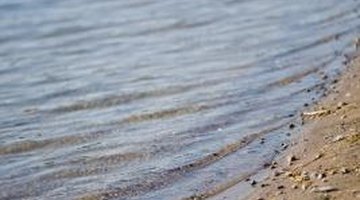Examples of Pond Succession
Succession is the natural process by which a pond changes without human intervention. The pond will return to its undisturbed natural balance or evolve as its life forms mature and water tables fluctuate. A pond that was dug on land that was cleared and cultivated will, over time and with deliberate neglect, fill in. The land will return to marsh, bog, meadow or forest habitat with attendant life forms. Such a recovery can take many years, but it follows some simple steps.
Pond Pioneers

When a pond is left to return to its natural state, it begins to change. Animals are attracted to the pond and create habitats there. Birds fly over the pond, dropping seeds and twigs. The earliest arrivals are the pond pioneers. They show up in the stage called primary succession. In a Maryland pond, single-celled algae called phytoplankton would be pioneers. They would be followed by more advanced stages of plants as the nature of the pond changes, attracting ever more sophisticated residents.
Submergent Vegetation
Various life forms arrive at the pond and the debris level increases at the bottom. Slowly the pond floor begins to rise. As it does, pondweed and submergent vegetation begin to grow across the bottom of the pond. Toronto's Tommy Thompson Park has a number of different stages of dry land and wetland. In Triangle Pond, under the right conditions of water clarity, nutrient bloom and water level, the submergent layer is sometimes visible with plants such as the Northern water milfoil, coontail and Richardson's pondweed along with the emergent White waterlily.
Emergent Plants
Emergent plants begin to grow at the edges of the pond. These are plants that have their roots in and under the water and part of their body above the water. The plants grow and die, and slowly the layers of decayed vegetation build up. The pond floor continues to rise. On Nantucket Island, the glacial ponds have been returning to land for millennia. As the emergent plants at the edges of the ponds deposit their decaying matter, the ponds become smaller. The shallow water turns silty and conditions are right for an invasion of sphagnum moss. The moss can hold up to 25 times its weight in water, further depleting the pond. As layers of moss die and compress into the pond floor, the pond slowly transforms into a peat bog.
Marsh, Swamp, Meadow, Forest, Grassland
Over the years, the emergent plants grow across the entire floor of the pond as it fills in with debris and plants. At this point, the pond becomes a marsh. The swampy marshland supports an enormous number of plant and animal species. A pond may remain a marsh or it may continue to dry out and eventually be forest or grassland. Hilton Pond Center for Piedmont Natural History was land that had been grazed and cultivated for sixty years. When it was allowed to return to its natural balance, the pond filled in over more than two decades to become a new growth upland forest.
References
Writer Bio
Benna Crawford has been a journalist and New York-based writer since 1997. Her work has appeared in USA Today, the San Francisco Chronicle, The New York Times, and in professional journals and trade publications. Crawford has a degree in theater, is a certified Prana Yoga instructor, and writes about fitness, performing and decorative arts, culture, sports, business and education .
Photo Credits
- Jupiterimages/Photos.com/Getty Images
More Articles



